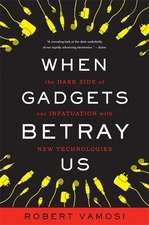24/7: How Cell Phones and the Internet Change the Way We Live, Work, and Play
Autor Jarice Hansonen Limba Engleză Hardback – 29 iul 2007 – vârsta până la 17 ani
Preț: 363.38 lei
Preț vechi: 478.67 lei
-24% Nou
Puncte Express: 545
Preț estimativ în valută:
69.54€ • 72.33$ • 57.41£
69.54€ • 72.33$ • 57.41£
Carte tipărită la comandă
Livrare economică 12-26 aprilie
Preluare comenzi: 021 569.72.76
Specificații
ISBN-13: 9780275993337
ISBN-10: 0275993337
Pagini: 176
Dimensiuni: 156 x 235 x 20 mm
Greutate: 0.42 kg
Editura: Bloomsbury Publishing
Colecția Praeger
Locul publicării:New York, United States
ISBN-10: 0275993337
Pagini: 176
Dimensiuni: 156 x 235 x 20 mm
Greutate: 0.42 kg
Editura: Bloomsbury Publishing
Colecția Praeger
Locul publicării:New York, United States
Notă biografică
Jarice Hanson is Professor of Communication at the University of Massachusetts, Amherst, and Verizon Chair in Telecommunications at the School of Communications and Theater at Temple University in Philadelphia. She is the author/editor of seventeen books.
Recenzii
Hanson provides a concise, readable overview of the impact of cell phones and the Internet on every aspect of our lives, from individual habits and relationships to national and international social and cultural norms. Cell phones and the Internet offer users an illusion of greater control over their lives, but they also lead to expectations and behavior changes that can cause stress and anxiety and threaten or at least alter social and political structures. Others have raised these issues, but Hanson has collected solid data from many sources, which she presents in clear, well-organized chapters spiced with good examples and anecdotes.. Highly recommended. General readers; students, upper-division undergraduates and up; faculty and practitioners.
Hanson explores the cultural impact in the United States of widespread and growing cell phone and Internet access and use. First providing a sociological profile of who uses these communication technologies and why, she subsequently offers chapters that examine the way some people lose personal control over their use of these technologies, the technologies' uses as avenues of public information exchange, social networking and loss of privacy, developing issues of copyright and intellectual property, and impacts on older technologies such as public telephone booths and traditional media.
Hanson explores the cultural impact in the United States of widespread and growing cell phone and Internet access and use. First providing a sociological profile of who uses these communication technologies and why, she subsequently offers chapters that examine the way some people lose personal control over their use of these technologies, the technologies' uses as avenues of public information exchange, social networking and loss of privacy, developing issues of copyright and intellectual property, and impacts on older technologies such as public telephone booths and traditional media.













